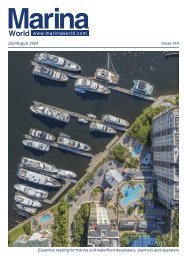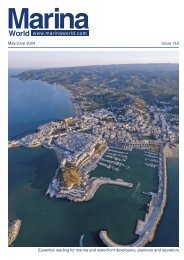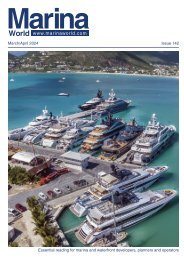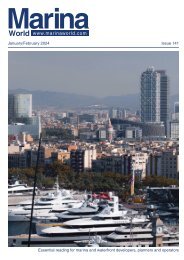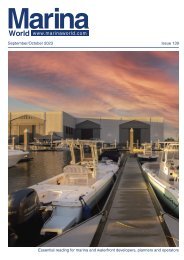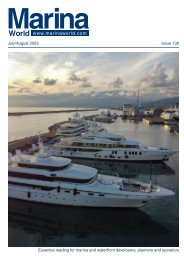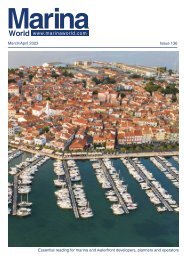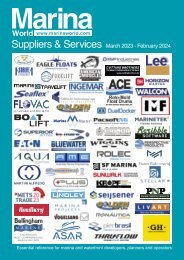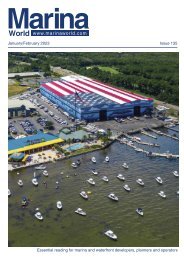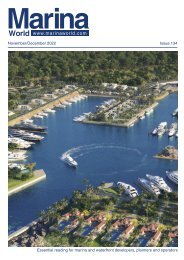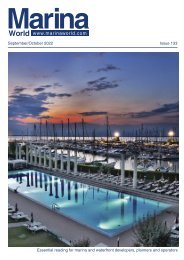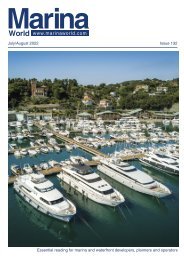2023 May June Marina World
The magazine for the marina industry
The magazine for the marina industry
Create successful ePaper yourself
Turn your PDF publications into a flip-book with our unique Google optimized e-Paper software.
DRYSTACK STORAGE<br />
<strong>Marina</strong> Arenella is perhaps the largest<br />
and most efficient drystack in Italy and is<br />
located at the northern end of Sicily’s Gulf<br />
of Palermo.<br />
Wet versus dry in the<br />
western Med<br />
The western Mediterranean, although a favourite international boating<br />
destination, is not big on drystack. Due to rules, laws, limited land space and<br />
customer preference, just a few in fact exist – and these are mostly uncovered<br />
or only active in the summer season. Donatella Zucca reports<br />
Roberto Perocchio, president of<br />
Italian marina association Assomarinas,<br />
explains: “Average Italians, and maybe<br />
‘Mediterraneans’ in general, don’t like<br />
being restricted by times and rules.<br />
The freedom of having a boat on the<br />
water tends to outweigh the advantages<br />
offered by a traditional drystack.”<br />
Exceptions to this trend may be found<br />
in urban situations where demand for<br />
berths exceeds availability but it is<br />
nonetheless difficult to modify urban<br />
planning, obtain permits or construct<br />
drystacks at existing marinas (where<br />
sufficient land is not usually available)<br />
or build them from scratch.<br />
Variety in Italy<br />
Although it enjoys a central<br />
Mediterranean position, a long<br />
coastline, many islands and a number<br />
of well-equipped marinas, drystacks are<br />
a rarity in Italy. This is surprising given<br />
the excellent health of its marina sector,<br />
which according to Confindustria<br />
Nautica enjoyed a turnover of around<br />
€1 billion in 2022. In the last ten years,<br />
the country has been enriched by 40<br />
marinas and 22,000 berths but, in<br />
part due to the challenges of finding<br />
sites and obeying laws, drystack<br />
development has been difficult.<br />
“Combining a building with access<br />
to the sea is always very complex,”<br />
Perocchio says. “If a suitable building<br />
exists and you can get permission for<br />
change of use, this is easier than trying<br />
to build new; a mission that is almost<br />
impossible due to laws that protect the<br />
coast.”<br />
In years past it was easier, as can<br />
be found at the Consorzio Cantieristica<br />
Minore della Giudecca in Venice, where<br />
a state-of-the-art covered drystack<br />
storage operation was created years<br />
ago in the historic city centre. Venice<br />
is, however, on the Adriatic – and the<br />
Adriatic veers more to the east than<br />
the west. Perocchio continues: “With<br />
Confindustria Nautica, we are trying to<br />
explore this type of service by appealing<br />
to Article 49 of the New Pleasure<br />
Boating Code, which favours the issue<br />
of concessions for dry storage. However,<br />
the problems of slow urban planning,<br />
the scrutiny of various superintendents<br />
and other delays remains. Many<br />
operations have in fact been developed<br />
with only partial permissions, gradually<br />
establishing themselves and then<br />
obtaining an amnesty.”<br />
Most Italian drystacks are to be<br />
found in the south, especially in Sicily,<br />
although they are often variations on<br />
the theme. The largest and perhaps<br />
most efficient is <strong>Marina</strong> Arenella at<br />
the northern end of Sicily’s Gulf of<br />
Palermo. Equipped with three forklifts<br />
to rapidly lift, launch and store boats<br />
up to 13m (43ft) in length, the facility<br />
houses around 230 boats, 180 of which<br />
are stored on multi-storey racks, 30 in<br />
a covered building and the remainder<br />
on outdoor<br />
dry storage<br />
space. In the<br />
summer, about<br />
100 wet berths<br />
are available.<br />
“During our<br />
30 years of<br />
experience,<br />
we have<br />
Assomarinas.<br />
revolutionised the concept of the dry<br />
port,” says marina manager Massimo<br />
Acierno. “Customers can use their<br />
boats 24 hours a day, seven days a<br />
week because, once launched, the boat<br />
can stay in the water as long as the<br />
customer wants.”<br />
“In recent years, we have developed<br />
software that allows you to book a lift<br />
or launch, make special requests etc.,<br />
via a smartphone. The requests arrive<br />
via the app on displays located on<br />
the forklifts and in the back office. The<br />
customer<br />
is then told<br />
where to<br />
find the boat<br />
and given<br />
details on<br />
the services<br />
provided<br />
by smart<br />
pedestals.<br />
We have car<br />
parking, bar,<br />
Roberto Perocchio,<br />
Massimo Acierno,<br />
<strong>Marina</strong> Arenella.<br />
restaurant services, Wi-Fi, fuel, mooring<br />
assistance, a mechanical repair shop<br />
and shipyard. If we had a quay big<br />
enough to host a US-style drystack, we<br />
would be truly unbeatable!”<br />
Other dry ports in Catania include the<br />
Nautica Glem dry rack business and<br />
Vento Maestrale opposite the entrance<br />
to the port of Trapani. This efficient dry<br />
port caters for dinghies and small boats.<br />
<strong>Marina</strong> Capo d’Orlando has a beautiful<br />
drystack facility at planning stage but<br />
is not moving forward with it as it is<br />
devoting all its usable yard space to<br />
large boat storage.<br />
www.marinaworld.com – <strong>May</strong>/<strong>June</strong> <strong>2023</strong><br />
37



